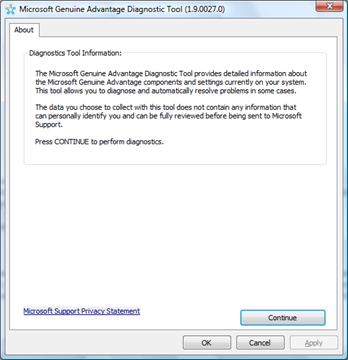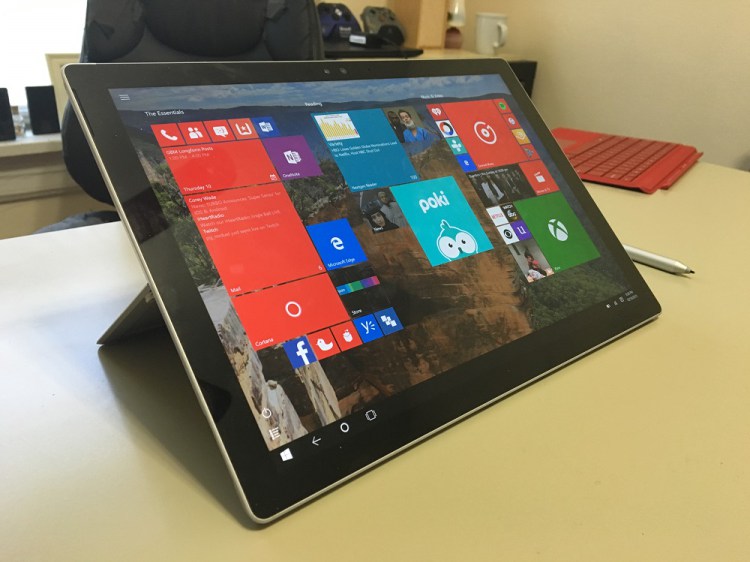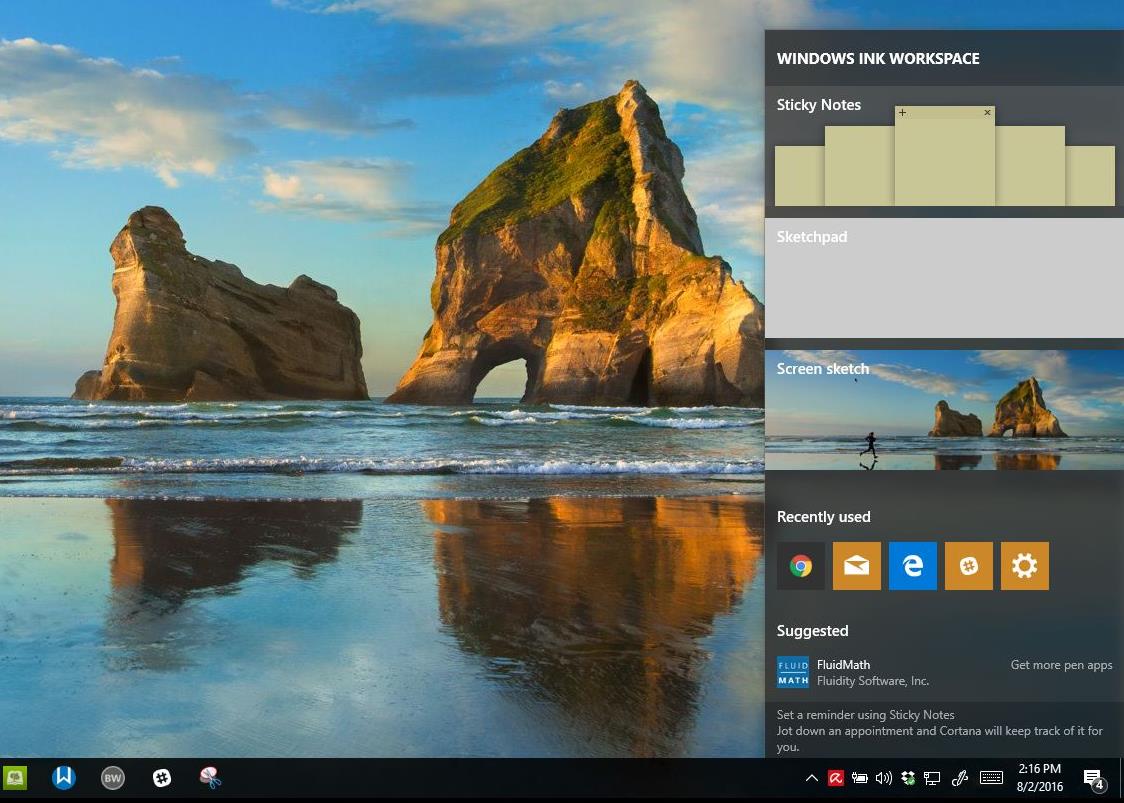Buying and using pirated software is a dangerous game to play for many reasons. If you’ve purchased Windows from an auction site or some other non-retail location you may not have a genuine version of Windows. Thankfully Microsoft has made it pretty easy to find out if you have a real copy of Windows. This guide will show you how to check whether your Windows installation is genuine.
Lets take a look at using the Microsoft Genuine Diagnostics Tool
The MSGDT provides an easy way to find out key information regarding your Windows licensing and can be used diagnose common problems with Windows Activation problems. In future article, we will take a look at using the Microsoft Genuine Diagnostics Tool (MSGDT) to diagnose and troubleshoot Activation problems.
Step 1: Download MSGDT here
Step 2: Once saved, run the tool.
Step 3: Click on the Continue button, which will produce the report.
Step 4: To copy the report to your results, click on the Copy button in the tool (ignore any error messages at this point), and then paste (using either r-click/Paste, or Ctrl+V ) into a text editor such as NotePad or WordPad (preferably WordPad).
The first thing we are going to look at is the product identification.
Diagnostic Report (1.9.0027.0):
————————————————————————————–
Windows Validation Data–>
Validation Code: 50
Cached Online Validation Code: 0x0
Windows Product Key: *****-*****-AAAAA-BBBBB-CCCCC
Windows Product Key Hash: uniSKNJNgGH/kpdR+KWVmDElfq0=
Windows Product ID: XXXXX-067-XXXXXXX-XXXXX
Windows Product ID Type: 5
Windows License Type: Retail
Windows OS version: 6.1.7600.2.00010100.0.0.001
—————————————————————————————-
The highlighted 067 tells us the channel from which the software originated, which is either MSDN or TechNet. This tells us immediately if you are running software from a channel from which it is for evaluation purposes only. Also if it has one of the following examples below you probably have an MSDN key.
065, 066, 067, 068 for Ultimate, 220 area for Pro and the 230, 231, 221 area for Home Premium, there are probably others but they should be close to the ones I have listed here.
Other information you can look at too is the Licensing Data:
—————————————————————————————
Licensing Data–>
Software licensing service version: 6.0.6002.18005
Name: Windows(TM) Vista, Business edition
Description: Windows Operating System – Vista, OEM_SLP channel
Activation ID: fd3bcb98-5c55-4b2d-ae32-a4515e3c17a3
Application ID: 55c92734-d682-4d71-983e-d6ec3f16059f
Extended PID: 89584-00146-321-400039-02-1033-6001.0000-3362008
Installation ID: 019730227492214585406233828444513601479652905332893231
———————————————————————————————
In the above example, the following describes additional information about the channel it is intended for. If you are certain you bought a retail Windows License and you see OEM_SLP Channel, that’s a bad sign. What some clever pirates are able to do is use a hacked OEM BIOS (DELL, Lenovo, Gateway, HP) which does not require activation of their Windows licenses are used to create Frankenstein installations that can bypass activation on any computer.
This results in the software being used in the wrong channel and on systems they are not intended for. You can notice this easily too, for example, if you have a HP system, and you installed one of these hacked OEM Windows 7 installations, when you you click Start, right click Computer > click Properties > you will end up seeing a logo for a different OEM brand logo under System Type.
More about OEM_SLP licenses and how they work:
Computers, which are built by large manufactures that come with Windows Pre-Installed, come with two (2) Product Keys:
A) OEM SLP: This key comes pre-installed in Windows, when it comes from the Factory. This key is geared to work with the OEM Bios Flag found only on that Manufacturer’s computer hardware. So when Windows was installed using the OEM SLP key (at the factory) Windows looks at the motherboard and sees the proper OEM Bios Flag (for that Manufacturer and that version of Windows) and Self-Activates. (that’s why you did not need to Activate your computer after you brought it home)
B) COA SLP: This is the Product key that you see on the sticker on the side (or bottom) of your computer. It is a valid product key, but should only be used in limited situations (such as if the OEM SLP key stops self-activating for whatever reason). The key must be activated by Phone. (Note: All manufacturers that use the OEM SLP system are required by contract to include a Certificate of Authenticity (COA) sticker, that has a COA SLP key, on the computer)
Your Windows is using an OEM SLP key, but (for whatever reason) cannot see the special instructions in the computer’s motherboard and is unable to Self-Activate.
To fix the issue, you will need to change out the OEM SLP key with the COA SLP key. The normal way to do this is to click the ‘Start’ button, right-click ‘Computer’, select ‘Properties’ and then click ‘Change Product Key’ (located in the lower right-hand side of the window). Enter the COA SLP key and follow the instructions in the Change Product Key Wizard.
Steps to Take
If you discover that your key is indeed a non-genuine license, there certain actions you can take to resolve this matter. The first one, is to try demanding a refund from the source or channel you purchased the software. If this option does not work out (usually it doesn’t), either you get no response from the source because you have discovered what they did. The next thing to do even if you do get a refund is to report the vendor to Ebay here The next step is to report it to Microsoft:
Method 1: E-mail [email protected].
Method 2: Call the Microsoft Anti-Piracy Hotline at (800) RU-LEGIT.
Method 3: Fill out an online reporting form.
So, you have done your part, now what about the non-genuine software that is still installed on your computer? I checked Microsoft’s How To Tell website, but did not find a clear explanation of what must be done in terms of compensation or how to get a genuine replacement.
The Report Suspected Piracy page though does provide a detailed form with instructions about how to report the software, description, place of purchase, time of purchase that can help resolve the issue. It is assumed that the option to provide personal information will allow Microsoft to contact you and follow-up with the issue.
The next option is the Microsoft Product Key Update Tool. One of these steps will let you check to see whether you can use the online Product Key Update Tool. If your computer came with a genuine product key, but Windows was improperly installed using an invalid product key, the Product Key Update Tool helps convert your computer to a genuine status without having to purchase a new copy of Windows. If this solution does not work, refer to the instructions here for what to do when your system fails validation.
One of things I should point out, usually the non-genuine software is purchased at too good to be true prices compared to the retail product, so the loss is usually minimal in some cases. So, the best recommendation going forward would be to purchase from a reputable source such as the Microsoft Store or a retail store software and computer products are sold. Some online stores allow resellers to retail products through their stores, called merchants. Persons for example have purchased Windows software through Amazon.com only to find out it’s a non-genuine license. So make sure you buying directly from Amazon. If you have any questions, please post in the comments.
Resources:






